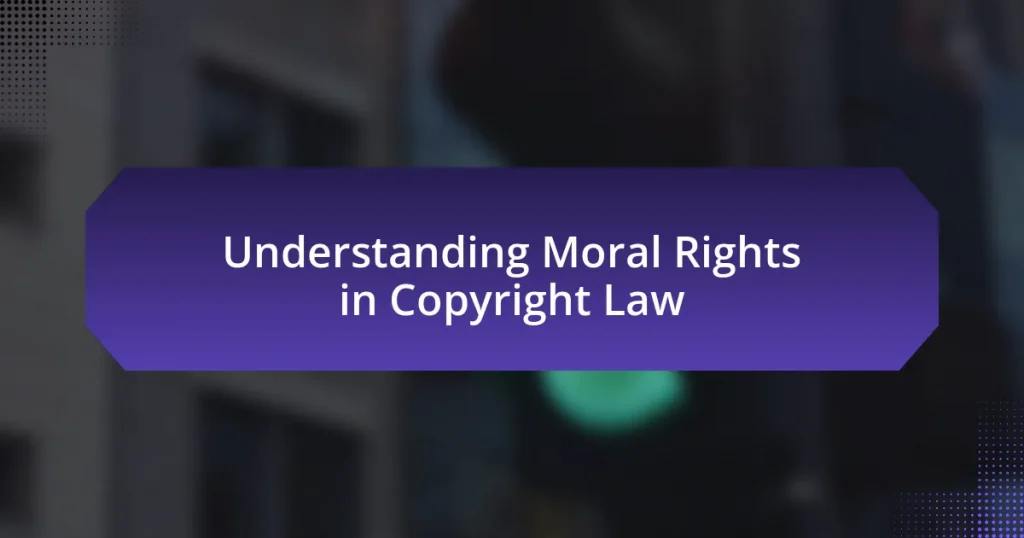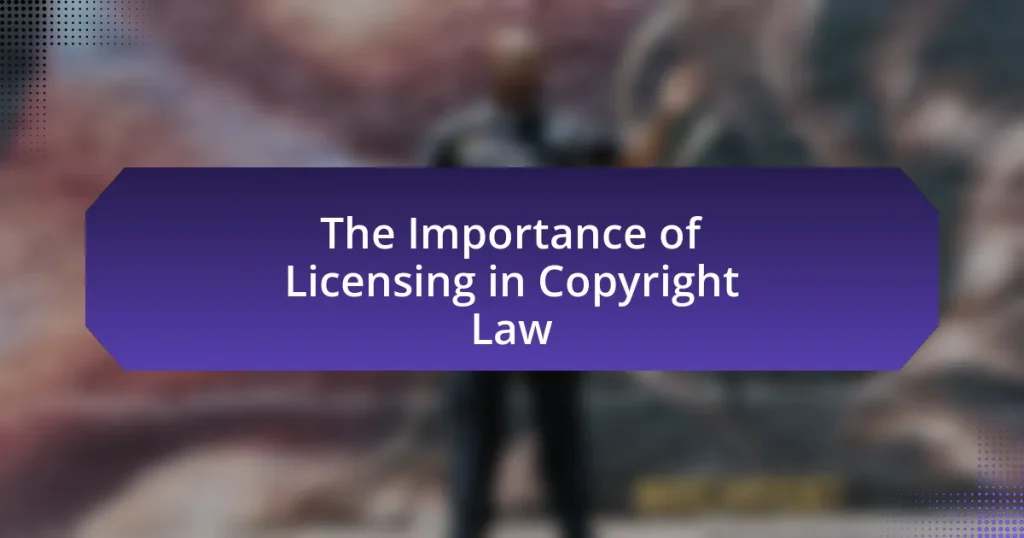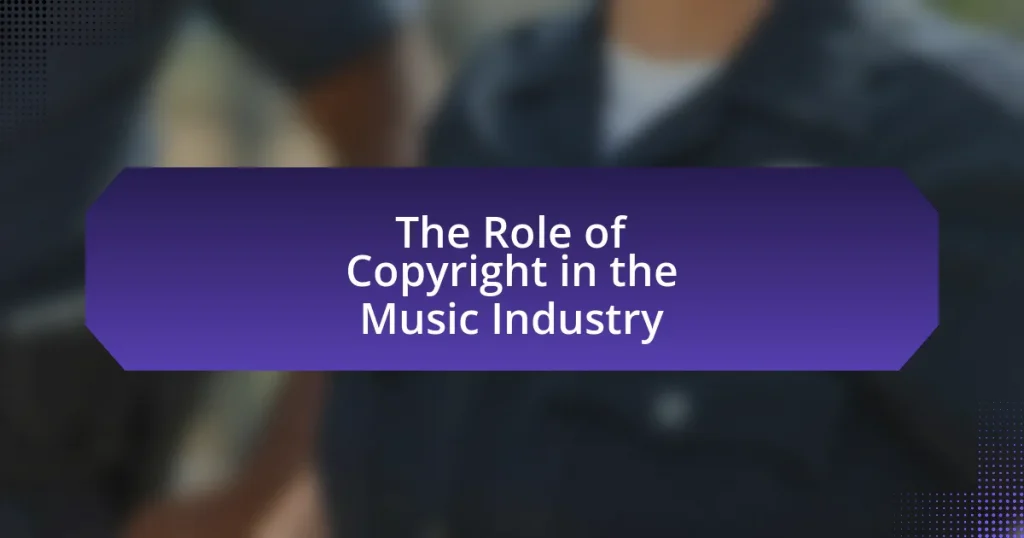Copyright law for photographers is a legal framework that grants exclusive rights to original photographic works, protecting against unauthorized use, reproduction, or distribution. This article outlines the key components of copyright law relevant to photographers, including automatic protection upon creation, the rights photographers hold, and the importance of registration for enhanced legal protections. It also discusses the implications of copyright infringement, the concept of fair use, and best practices for safeguarding creative work. Additionally, practical tips for navigating copyright law, including documentation and reporting of infringements, are provided to help photographers effectively protect their rights and maximize their career potential.
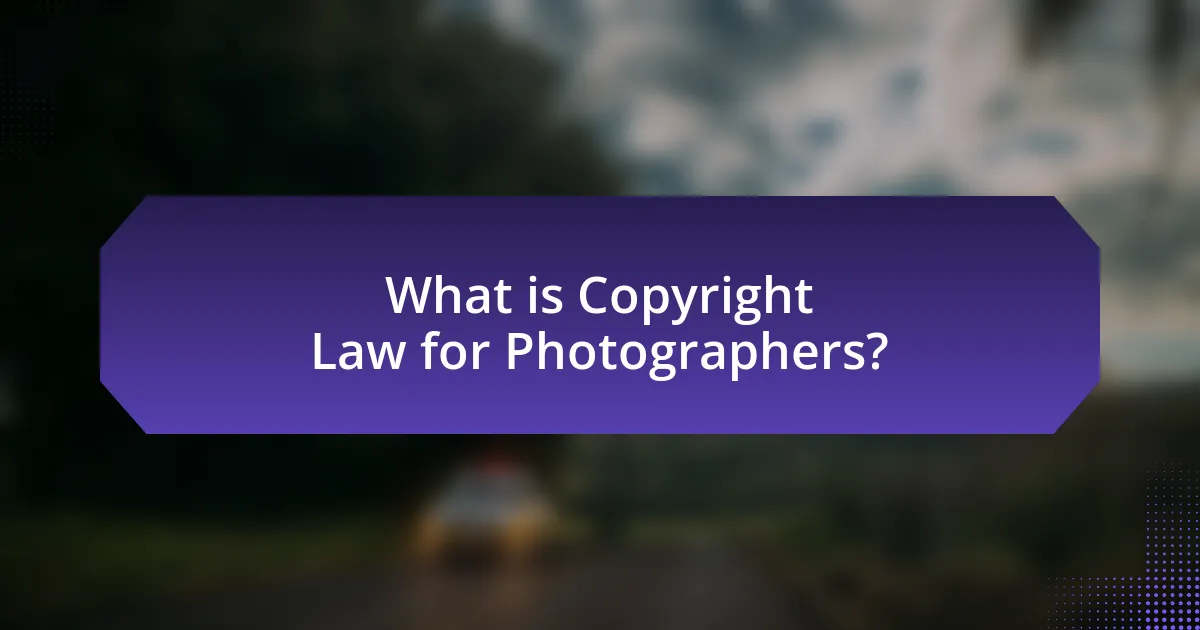
What is Copyright Law for Photographers?
Copyright law for photographers grants them exclusive rights to their original photographic works, protecting against unauthorized use, reproduction, or distribution. This legal framework ensures that photographers maintain control over how their images are used and can seek compensation for infringement. Under the U.S. Copyright Act of 1976, photographers automatically receive copyright protection upon the creation of their work, without the need for registration, although registering can enhance legal protections and remedies. This law is crucial for safeguarding the creative and financial interests of photographers in a digital age where images can be easily shared and misappropriated.
How does copyright law protect photographers’ work?
Copyright law protects photographers’ work by granting them exclusive rights to their original photographs, preventing unauthorized use, reproduction, or distribution. This legal framework ensures that photographers maintain control over how their images are used and can seek legal recourse against infringers. Under the Copyright Act of 1976 in the United States, for example, photographers automatically receive copyright protection upon the creation of their work, without the need for registration, although registering can enhance their ability to enforce their rights. This protection lasts for the life of the photographer plus 70 years, allowing them or their heirs to benefit financially from their creative efforts.
What rights do photographers have under copyright law?
Photographers have exclusive rights to their original photographs under copyright law, which includes the right to reproduce, distribute, display, and create derivative works from their images. This legal protection is established by the Copyright Act of 1976 in the United States, which grants copyright automatically upon the creation of a work fixed in a tangible medium. Photographers can enforce these rights against unauthorized use, ensuring they receive recognition and compensation for their creative efforts.
How does copyright law apply to different types of photography?
Copyright law grants photographers exclusive rights to their original works, regardless of the type of photography. This means that photographers automatically hold copyright over their images as soon as they are created and fixed in a tangible medium. For instance, commercial photography, which is often used for advertising and marketing, allows photographers to license their images for profit while retaining ownership. In contrast, fine art photography may focus on artistic expression, where copyright protects the photographer’s creative vision and prevents unauthorized reproductions. Additionally, documentary photography, which captures real-life events, is also protected under copyright law, ensuring that the photographer’s unique perspective is safeguarded. The U.S. Copyright Office states that copyright protection applies to “original works of authorship,” which includes all forms of photography, thus reinforcing the legal framework that supports photographers across various genres.
Why is understanding copyright law important for photographers?
Understanding copyright law is crucial for photographers because it protects their creative work from unauthorized use and ensures they retain ownership rights. Photographers who grasp copyright law can effectively safeguard their images, allowing them to control how their work is used and to seek compensation for its use. According to the U.S. Copyright Office, copyright protection is automatic upon the creation of an original work, which underscores the importance of understanding these rights to prevent infringement and to navigate licensing agreements properly.
What are the potential consequences of copyright infringement?
The potential consequences of copyright infringement include legal penalties, financial damages, and loss of reputation. Legal penalties can involve lawsuits, where the infringer may face statutory damages ranging from $750 to $30,000 per work infringed, or even up to $150,000 for willful infringement, as established by the U.S. Copyright Act. Financial damages may also encompass the payment of attorney fees and court costs, further increasing the financial burden on the infringer. Additionally, copyright infringement can lead to a damaged reputation, which may affect future business opportunities and relationships within the industry.
How can knowledge of copyright law enhance a photographer’s career?
Knowledge of copyright law can significantly enhance a photographer’s career by empowering them to protect their creative work and monetize it effectively. Understanding copyright allows photographers to assert their rights over their images, preventing unauthorized use and potential infringement, which can lead to financial losses. For instance, the U.S. Copyright Office states that copyright protection is automatic upon the creation of an original work, enabling photographers to take legal action against infringers. Additionally, knowledge of licensing options, such as exclusive and non-exclusive licenses, enables photographers to negotiate better contracts and maximize their income from their work. This legal awareness not only safeguards their artistic integrity but also enhances their professional reputation in the industry.
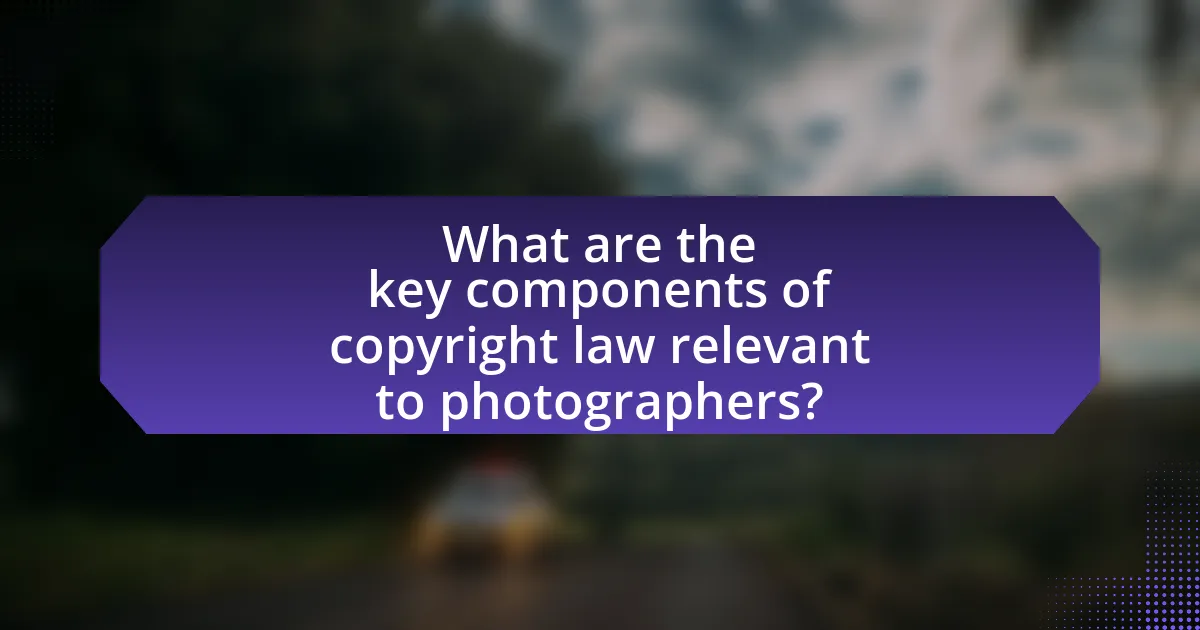
What are the key components of copyright law relevant to photographers?
The key components of copyright law relevant to photographers include the automatic protection of original works, the exclusive rights granted to creators, and the duration of copyright. Copyright law automatically protects original photographs as soon as they are created and fixed in a tangible medium, meaning photographers do not need to register their work to obtain rights. Photographers hold exclusive rights to reproduce, distribute, display, and create derivative works from their images, which allows them to control how their work is used and monetized. The duration of copyright protection for photographs is typically the life of the creator plus 70 years, ensuring long-term control over the work. These components are established under the U.S. Copyright Act of 1976 and are consistent with international copyright treaties, reinforcing the legal framework that supports photographers’ rights.
What is the process of registering a photograph for copyright?
The process of registering a photograph for copyright involves submitting an application to the U.S. Copyright Office. This application requires the completion of a form, payment of a fee, and submission of a copy of the photograph. The U.S. Copyright Office provides specific guidelines for the application process, including the need for the photograph to be an original work fixed in a tangible medium. Registration can be completed online or via mail, and it is advisable to register to enhance legal protection and establish a public record of the copyright.
How does registration affect a photographer’s legal rights?
Registration significantly enhances a photographer’s legal rights by providing a public record of ownership and establishing a legal presumption of copyright validity. When a photographer registers their work with the U.S. Copyright Office, they gain the ability to sue for statutory damages and attorney’s fees in cases of infringement, which are not available for unregistered works. Additionally, registration serves as evidence in court, making it easier to prove ownership and the date of creation, which can be crucial in disputes. According to the U.S. Copyright Office, registration is a prerequisite for filing a lawsuit for infringement, underscoring its importance in protecting a photographer’s rights.
What are the costs and requirements for copyright registration?
The costs for copyright registration in the United States typically range from $35 to $55, depending on the method of registration and the type of work being registered. The requirements for copyright registration include completing an application form, providing a copy of the work being registered, and paying the applicable fee. The U.S. Copyright Office mandates that the work must be original and fixed in a tangible medium of expression to qualify for registration.
What constitutes fair use in photography?
Fair use in photography is defined as the limited use of copyrighted material without permission from the copyright owner, typically for purposes such as criticism, comment, news reporting, teaching, scholarship, or research. The determination of fair use involves a case-by-case analysis based on four factors: the purpose and character of the use (commercial vs. educational), the nature of the copyrighted work (creative vs. factual), the amount and substantiality of the portion used in relation to the whole work, and the effect of the use on the market for the original work. Courts have upheld fair use in various cases, such as the 1994 case of Campbell v. Acuff-Rose Music, which established that transformative use can qualify as fair use, emphasizing the importance of context in evaluating each situation.
How can photographers determine if their work falls under fair use?
Photographers can determine if their work falls under fair use by evaluating four key factors established in copyright law: the purpose and character of the use, the nature of the copyrighted work, the amount and substantiality of the portion used, and the effect of the use on the market for the original work. The first factor considers whether the use is for commercial or educational purposes, with educational uses more likely to qualify as fair use. The second factor assesses whether the work is factual or creative, with factual works having a higher chance of fair use. The third factor examines how much of the original work is used; using a small portion may favor fair use. Lastly, the fourth factor looks at whether the new work negatively impacts the market value of the original, with a lack of market harm supporting a fair use claim. These factors are derived from the U.S. Copyright Act and have been upheld in various court cases, providing a framework for photographers to analyze their specific situations.
What are common misconceptions about fair use in photography?
Common misconceptions about fair use in photography include the belief that any use of a photograph without permission is permissible if it is for educational or non-commercial purposes. This is incorrect; fair use is determined by specific factors, including the purpose of use, the nature of the copyrighted work, the amount used, and the effect on the market value of the original work. Another misconception is that crediting the photographer or source automatically qualifies as fair use, which is not true; attribution does not negate copyright infringement. Additionally, many assume that using a small portion of a photograph guarantees fair use, but even minimal use can infringe if it affects the market for the original work. These misconceptions can lead to legal issues for photographers and users alike.

What best practices should photographers follow regarding copyright?
Photographers should register their works with the U.S. Copyright Office to establish legal ownership and facilitate enforcement of their rights. Registration provides a public record of the copyright and is necessary for filing a lawsuit for infringement. Additionally, photographers should include copyright notices on their images, which serve as a deterrent against unauthorized use and inform the public of their rights. It is also essential for photographers to maintain detailed records of their work, including dates, locations, and any agreements made with clients or subjects, as this documentation can support claims of ownership. Furthermore, photographers should familiarize themselves with licensing agreements to clearly define how their images can be used, ensuring they retain control over their work while allowing for potential revenue streams.
How can photographers effectively protect their work?
Photographers can effectively protect their work by obtaining copyright registration for their images. Copyright registration provides legal recognition of ownership, enabling photographers to enforce their rights against unauthorized use. According to the U.S. Copyright Office, registered works are eligible for statutory damages and attorney’s fees in case of infringement, which can significantly enhance a photographer’s ability to seek compensation. Additionally, photographers should use watermarks and metadata to deter unauthorized use and maintain a record of their work’s origin. These practices collectively strengthen a photographer’s legal standing and help safeguard their creative output.
What are the best methods for watermarking and licensing images?
The best methods for watermarking and licensing images include digital watermarks, visible watermarks, and licensing agreements. Digital watermarks embed information within the image file that is not visible to the naked eye, allowing for tracking and identification of ownership. Visible watermarks, such as logos or text, deter unauthorized use by making it clear that the image is protected. Licensing agreements, which outline the terms of use for the image, provide legal protection and clarify the rights granted to users. According to a study by the International Journal of Information Management, effective watermarking can reduce unauthorized use by up to 80%, demonstrating the importance of these methods in protecting photographers’ rights.
How can photographers monitor the use of their images online?
Photographers can monitor the use of their images online by utilizing reverse image search tools and digital rights management services. Reverse image search tools, such as Google Images and TinEye, allow photographers to upload their images or input URLs to find where their images appear on the internet. Digital rights management services, like Pixsy and ImageRights, provide automated tracking and reporting of unauthorized use, enabling photographers to take action against copyright infringement. These methods are effective as they leverage existing technology to identify unauthorized usage, ensuring photographers can protect their intellectual property rights.
What steps should photographers take if their copyright is infringed?
Photographers should first document the infringement by collecting evidence, such as screenshots or copies of the unauthorized use. This documentation serves as proof of the infringement. Next, photographers should contact the infringer directly, informing them of the copyright violation and requesting the removal of the infringing material. If the infringer does not comply, photographers can send a formal cease-and-desist letter, which outlines the legal implications of continued infringement. If these steps do not resolve the issue, photographers may consider filing a Digital Millennium Copyright Act (DMCA) takedown notice with the hosting platform or seek legal counsel to explore further legal action. These steps are essential for protecting their rights and enforcing copyright laws effectively.
How can photographers document and report copyright infringement?
Photographers can document and report copyright infringement by collecting evidence of the unauthorized use of their work, such as screenshots, URLs, and timestamps. This documentation should include details about the original work, the infringing use, and any relevant context, such as the date of the infringement and the location where it was found. Photographers can then report the infringement to the platform hosting the infringing content, utilizing the Digital Millennium Copyright Act (DMCA) takedown notice process, which requires a formal complaint that includes the documented evidence. According to the U.S. Copyright Office, this process is a legal mechanism designed to protect copyright holders and facilitate the removal of infringing content.
What legal options are available for photographers facing infringement issues?
Photographers facing infringement issues have several legal options available to them, including sending a cease-and-desist letter, filing a Digital Millennium Copyright Act (DMCA) takedown notice, and pursuing a lawsuit for copyright infringement. A cease-and-desist letter formally requests the infringer to stop using the copyrighted work, while a DMCA takedown notice can be submitted to online platforms hosting the infringing content, prompting them to remove it. If these measures do not resolve the issue, photographers can file a lawsuit, which may lead to monetary damages or injunctive relief. According to the U.S. Copyright Office, copyright owners have the exclusive right to reproduce, distribute, and display their works, reinforcing the legal standing of photographers in these situations.
What practical tips can photographers implement to navigate copyright law?
Photographers can navigate copyright law by understanding their rights, registering their work, and using contracts. First, photographers should familiarize themselves with copyright laws, which grant them exclusive rights to their original works upon creation. Registering their photographs with the U.S. Copyright Office provides legal advantages, including the ability to sue for statutory damages and attorney fees in case of infringement. Additionally, using contracts when licensing images ensures clear terms regarding usage rights, compensation, and attribution, which can prevent disputes. These practices are supported by the Copyright Act of 1976, which outlines the rights of creators and the importance of registration for enforcement.

